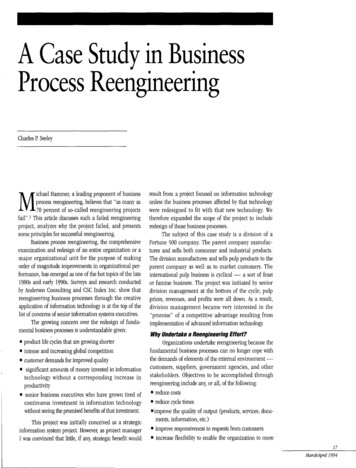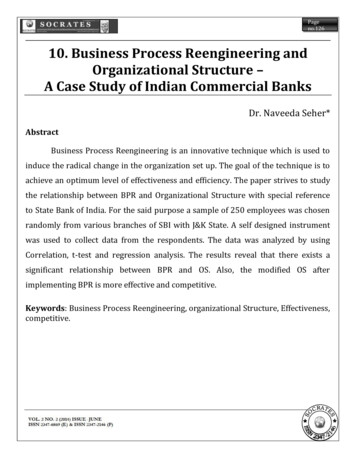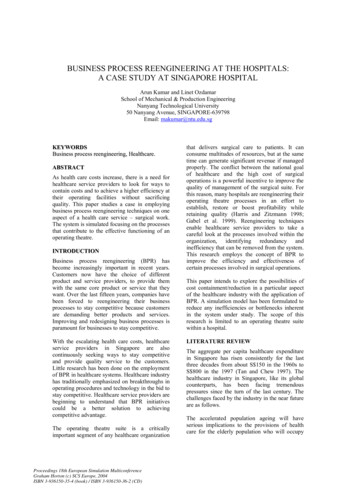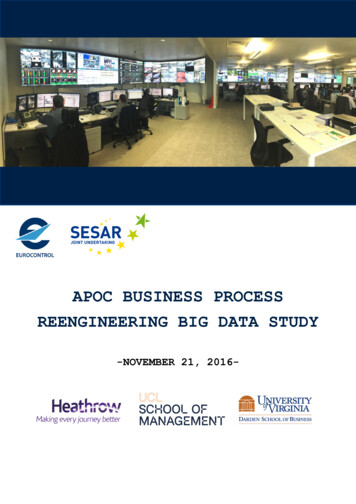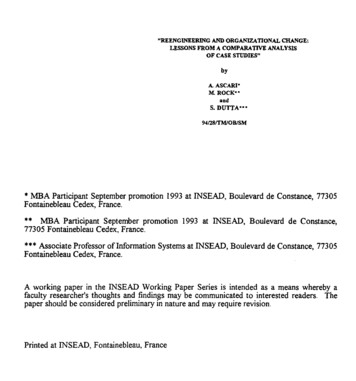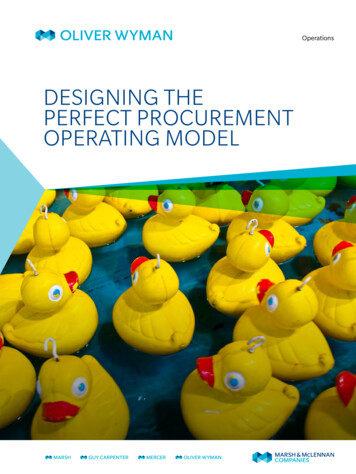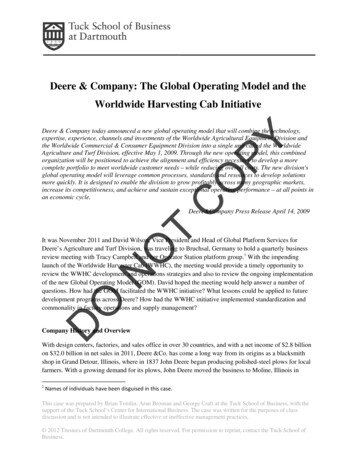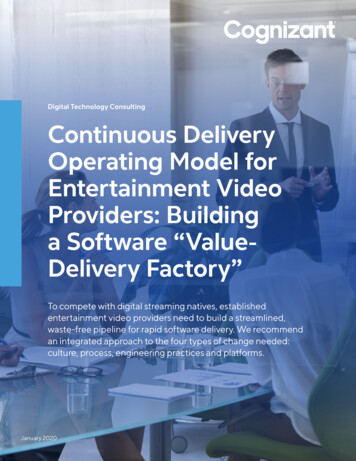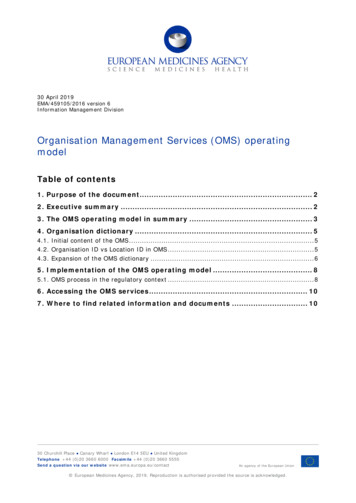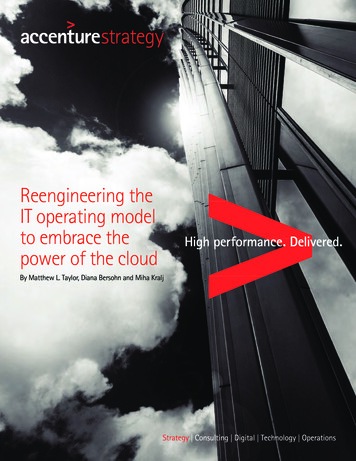
Transcription
Reengineering theIT operating modelto embrace thepower of the cloudBy Matthew L. Taylor, Diana Bersohn and Miha Kralj
Netflix. Spotify. Airbnb.Just a few globally known brandsborn on the cloud. Fast. Able to pivotto changing marketplace conditions.Marketplace disruptors. Universallyadmired.Measuring them against incumbentcompanies shackled with legacysystems is like comparing a minivanto a sports car. Soup-up the minivan’sengine and it will still finish last.Winning companies will be those thatreengineer their IT operating modelto race ahead in the high-speed,service-based world underpinned bycloud technology.2 Reengineering the IT operating model to embrace the power of the cloud
Everyone is talking about the cloud and the companies that were born becauseof it. Thanks to cloud technology, and other anything-as-a-service models, newplayers have been able to redefine their businesses in ways that were impossibleeven a handful of years ago, creating massively scalable and resource-elasticbusinesses that are clobbering incumbents. Many traditional businesses have failedto realize the full power of the cloud because they have taken the new technologyand deployed it using their existing IT operating model.Harnessing cloud—and the as-a-service muscle that comeswith it—means reengineering the IT organization and theway the company operates. It requires letting go of oldcommand-and-control service delivery and operatingmodels, moving away from centralized structures thatvalue rigor and certitude, and instead, adopting new,nimble models where experimentation and innovationare at the forefront. The traditional IT organization stillhas a significant place in the enterprise for at least thecoming decade, but a larger portion of it will move tonew digital models.Making these changes will require companies to managetheir new high speed, digital organizations in an entirelynew paradigm, driving a different mindset across thecompany culture. Those that succeed can beat theirstart-up rivals at their own game by adapting to changingmarket conditions faster, while leveraging the value ofscale that has always been at the heart of the enterpriseorganizational structure. Those that do not will facecompetitive extinction down the road.3 Reengineering the IT operating model to embrace the power of the cloud
Thinking like a start-upGaining the advantage of cloud computing requiresrestructuring for the future. Accenture research showsthat 84 percent of executives believe the IT organizationis shifting from a traditional service provider to a servicebroker and offering XaaS.It is something that more nimble companies already do. Consider StubHub,the online ticketing service, for example1. The company did not develop itsown payment capabilities internally. Instead, it uses Braintree, a paymentgateway provider owned by eBay, to process credit card transactions. Withoutmaking these types of changes, today’s traditional, hierarchical structure istoo rigid to rapidly adopt the new technologies that are constantly evolving.It is critical for organizations to tap into an ecosystem of partners allowingfor scale and rapid change.Most incumbents still operate with organizational structures that requireinteractions across multiple teams to plan, build and deliver services fromstrategy and design, to implementation and run (SEE FIGURE 1). However, thesilos involved in each phase make speed to innovation and collaborationdaunting to achieve if not impossible.FIGURE 1 Legacy organization structureService Development, Management and OperationsCIOChiefDigitalOfficerMay beoutside of ITArchitectureStrategy AndPlanning LeadServiceDevelopmentLead4 Reengineering the IT operating model to embrace the power of the cloudServiceManagement &Operations fficerMay beoutside of IT
Incumbents need to create flat, self-accountable, delivery “service teams”(see “Service teams: A definition”) that work collaboratively as self-containedunits, without organizational barriers. In many cases, companies arebeginning with an interim service-oriented structure within the legacyorganization. Once the interim organization is in place and functional,migration to the target state begins and evolves over time. This newstructure minimizes traditional boundaries that impede collaboration.Since this is a change in the culture of a company, efforts with serviceteams should start small and focus on services that are easiest to deliver.Teams need to have the right mix of business and technology skills to enablethem to rapidly deliver those services as a self-contained team.These service teams offer increased agility and the ability to experimentwith new ideas—“fail fast” and move on to new innovations. According toAccenture research, more than half of senior executives surveyed (64 percent)believe independent service brokers or XaaS providers will deliver newcapabilities faster than the internal IT organization.2GE is perfecting the service team approach. In 2012, the company announcedplans to hire 1,300 IT and engineering professionals in its IT hub inMichigan3—at the time, GE’s largest collection of IT experts. Working inservice teams and focusing on innovation, GE’s reorganization has resultedin greater collaboration across diverse areas of expertise, smarter decisionmaking within teams to quickly change direction when needed, and fastertime to market with industry-leading services. Today, GE’s IT organizationplays a key role in driving efficiencies, both internally and externally—software that the company creates to improve internal productivityevolves into the products and services GE provides to its customers.45 Reengineering the IT operating model to embrace the power of the cloudService teams:A definitionThe concept of “serviceteams” is gaining tractionin today’s cloud-basedbusiness environment,and there is an abundanceof interpretations ofexactly what that means.Our definition of a serviceteam is a small groupresponsible for building,managing and runningany service. Since serviceteams are flat andself-autonomous, theyoperate more nimblythan teams associatedwith heavy comand-andcontrol structures.
New capabilities for cloudCompanies need to create a workforce strategy to shapethe future organizational structure, develop new ITcapabilities and roles, hone individuals’ skills and shiftthe culture to embrace change.New roles like Cloud Orchestration/Provisioning Manager, PersistenceManager, API Manager or Service Portfolio Manager can be mapped againstan anything-as-a-service operating model. For the foreseeable future, therewill be many speeds in our new business and technology world. Companiesmust adjust to these varying speeds and map the new roles accordingly.(SEE FIGURE 2).Clearly, change is underway with the advent of cloud technology:Eighty-seven percent of executives surveyed by Accenture believe that morethan a quarter of their workforce will shift because of cloud.5 Two-thirdsbelieve up to half of their organization will need to transform.FIGURE 2 Multi-speed organization structureCIOLegacy OrganizationServicesExecutive LeadLeadIT Services,Strategy andArchitecturePlanningLeadSecurity(Chief InformationSecurity Officer)LeadProgramManagementOfficeLeadService Team1LeadService Team2LeadService Team3LeadBusinessServicesService TeamsCoordination TeamsProvide Overall Strategy, governance andrelationship management capabilitiesEnd to End Service Development Management and OperationsAligned to existing leadership rolesAdapted / new leadership roles6 Reengineering the IT operating model to embrace the power of the cloud
CIOs that want to position themselves for the future needto focus on creating or maturing IT capabilities that havenot been at the forefront in the past—those critical tomanaging the new ecosystem for an XaaS model.These high priority capabilities and their associated roles include:Service Onboarding Provides support to customers to obtain new orenhanced services as automation enables rapid onboarding (minutes vs. days).It also entails giving instructions on how to use services, what new servicesmay be in the works, and helps with the initial roadmap and transitionplanning. Service onboarding requires the knowledge of an engineer andthe business acumen of a sales manager, with greater focus on configuringservices to meet user needs rather than detailing requirements to buildcustomized solutions. Change is being driven by the new self-service capability where users choose appropriate applications with the help of experts.Account Management Acting as a single point of contact for customers(internal or external), the account management function identifies demandfor new services and communicates new requirements and enhancementsto the service team. Account management also develops the business case.Strategic Vendor Management Partners are constantly changing dueto the introduction of new technologies and old ones fading away. The newvendor management and contracting requires ensuring external partners areinformed and remain aligned to the strategic direction of the organizationand its service requirements. This role coordinates and manages contractsbased on service level.Product Management/Architecture Requires understanding thecompetitive marketplace, beyond the enterprise, and translating the businessvalue of current and evolving technology capabilities. Skills required for thisarea are a blend of financial acumen, business domain knowledge, strategicunderstanding of current and emerging technology and disciplined planningthat balances customer (internal and external) demand along with budgetaryand strategic decision-making.Strategic Planning Operates as a dynamic and continuous activity,whereas old-school strategic planning was about establishing a directionand holding the course with little tolerance for deviations or changes.7 Reengineering the IT operating model to embrace the power of the cloud
Rising to the cloudDigital has come a long way in a short time. Yet in today’shigh speed, XaaS world, most IT organizations are lagging.Successful companies will be those that can effectivelymigrate to a new operating model. The result: responsive, agileIT organizations that lead the way toward future innovation.8 Reengineering the IT operating model to embrace the power of the cloud
Join the strategyContact the AuthorsMatthew L. Taylormathew.l.taylor@accenture.comDiana Bersohndiana.bersohn@accenture.comMiha Kraljmiha.kralj@accenture.comOther ContributorsMichael Foleym.j.foley@accenture.comSamantha Goldfedersamantha.goldfeder@accenture.comRavi Pothravi.poth@accenture.comReferencesAbout AccentureAccenture is a leading global professional servicescompany, providing a broad range of services andsolutions in strategy, consulting, digital, technologyand operations. Combining unmatched experience andspecialized skills across more than 40 industries and allbusiness functions—underpinned by the world’s largestdelivery network—Accenture works at the intersectionof business and technology to help clients improve theirperformance and create sustainable value for theirstakeholders. With approximately 384,000 people servingclients in more than 120 countries, Accenture drivesinnovation to improve the way the world works and lives.Visit us at www.accenture.comAbout Accenture StrategyAccenture Strategy operates at the intersection ofbusiness and technology. We bring together ourcapabilities in business, technology, operations andfunction strategy to help our clients envision andexecute industry-specific strategies that supportenterprise-wide transformation. Our focus on issuesrelated to digital disruption, competitiveness, globaloperating models, talent and leadership helps drive bothefficiencies and growth. For more information, follow@AccentureStrat or visit www.accenture.com/strategy.1 merchants/stubhub2 Accenture Technology Strategy Research, 2016.3 Are IT Jobs Coming Back? CIO Magazine, May 2012 ourcing-declines--are-it-jobs-comingback-.html4 CIO Interview: Jim Fowler, GE, Computer Weekly, Nov. 2016 nterview-Jim-Fowler-GE5 Accenture Technology Strategy Research, 2016.Copyright 2016 Accenture.All rights reserved.Accenture, its logo, andHigh Performance Deliveredare trademarks of Accenture.This document makes descriptive reference to trademarks that may be owned byothers. The use of such trademarks herein is not an assertion of ownership of suchtrademarks by Accenture and is not intended to represent or imply the existence ofan association between Accenture and the lawful owners of such trademarks.
the future organizational structure, develop new IT capabilities and roles, hone individuals’ skills and shift the culture to embrace change. New roles like Cloud Orchestration/Provisioning Manager, Persistence Manager, API Manager or Service Portfolio Manager can be mapped against an anything-as-a-service operating model. For the foreseeable future, there
